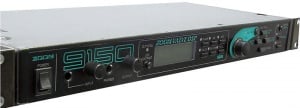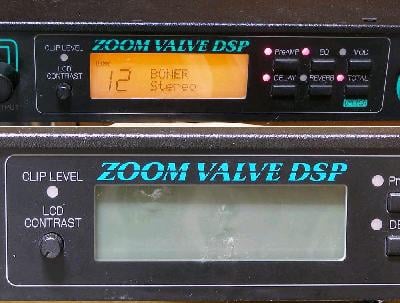Zoom 9150 review
Brand: ZOOM
Model: 9150 Valve DSP.
Type: 19" Rack Multi FX and Preamp.
Price: £450, $720 or Euro 483 when new. I paid £85, $135 or Euro 91 for mine.
Review by Sensible Jones.
Contents |
Introduction.
OK, I know that reviewing this Unit is a bit like reviewing the Horse, Stable and Bolt situation (due to it being 15 years old!!) but it was an important breakthrough in its day!
Secondly, I still use one today and it still sounds as good as it ever did, if not then slightly better even!!!
So, what’s all my shouting about?
It’s this...
The ZOOM 9150. A 19” Rack-mountable Valve Preamp Digital Sound Processor.
(Or Valve DSP as they like to label it on the front!)
DSP is ZOOM’s patented Sound Modelling system, like BOSS’s COSM or KORG’s REMS.
Overview.
What’s that??? Valve and Digital in the same Unit???
Yes, that’s exactly it!!
It has a Valve Preamp (single 12AX7A) followed by the fully programmable DSP, not too dissimilar from other Zoom Multi’s. It also has ‘Output Filtering’ so that you can still get a fairly good ‘Amp’ sound when DI’ing straight into a Desk or Recording Console.
As with most other ZOOM products this one is also equipped with the now famed ZNR (Zoom Noise Reduction). This system is invaluable in keeping all unwanted noise of high gain overdrive to an absolute minimum.
Also included in the Effects chain are not one BUT TWO External Effects Loops, allowing you to patch in other devices within the chain. The first of these Loops is programmable which allows for discretionary inclusion of an external device into any given Patch and position in the effects chain. The second Loop can also receive a Stereo Signal which can then be kept as Stereo through to the end of the effects chain and sent via the Zoom’s own stereo outs.
By using either an optional foot control or a MIDI device capable of sending controller information you have the option of being able to adjust certain parameters of the Modulation in ‘real time’.
A proprietary multi-pin connector is available for plugging in the optional Zoom FC50 or 8050 foot controllers. Both of which have the option of adding 2 extra ‘Expression Pedals’ (Zoom FP 02), Volume and one other assignable parameter in the case of the FC50 and both being assignable on the 8050. The 8050 is also capable of being MIDI controlled as well. Alternatively you could use something like a Behringer FCB 1010.
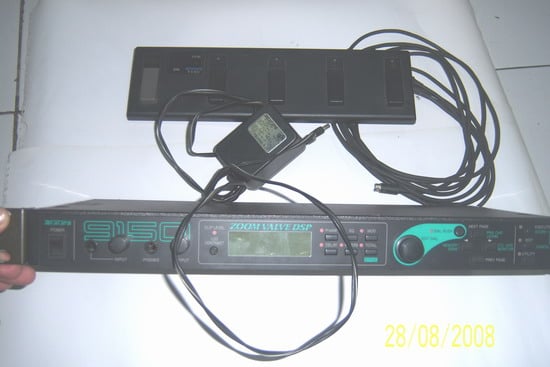
With the FC50 Controller.
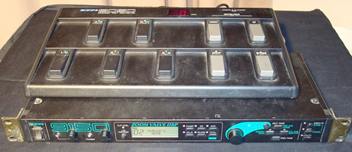
With an 8050 Controller.
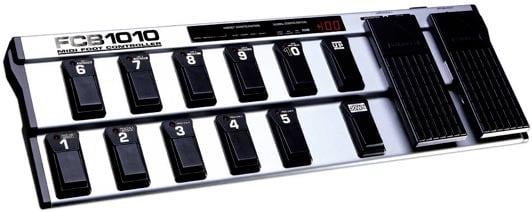
Behringer FCB 1010 MIDI Controller.
Front Panel.
As with a lot of Units aimed at Guitarists the front panel has a High Impedance Jack (with a ‘Line Level’ Input Jack on the rear panel), an ‘Input Level’, an ‘Output Level’ and a Headphone Socket for private practice. There’s a ‘Clip Level’ LED, the adjustable light LCD Screen, the different effect Block On/Off Buttons and a Rotary Controller and all the other buttons associated with editing a patch.
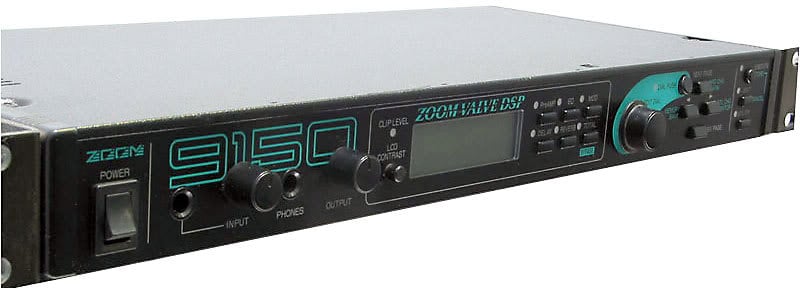
Display Sceen and Effects Block butttons.
Rear Panel.
The Rear panel contains the Power In, Line Level Input, insert for both external Insert FX Loops, Mono/Stereo Out, MIDI In/Out and the 9 Pin Din for optional Footswitch.
Insert 1 is mono in, mono out, while Insert 2 is mono send, stereo return, though it may also be used in mono. A nice touch is that Insert 2 may also be programmed (on a 'per-patch' basis) to be either in series or in parallel with the internal DSP effects. In parallel mode, it may be fed from either the Pre- or Post-EQ signal.
The Effects Chain.
Up to five effects can be used simultaneously, made up from the following blocks:
~ Preamp
~ EQ
~ Modulation
~ Delay
~ Reverb
The Preamp section offers eight different choices of clean, rhythm, overdrive and lead (very overdrive!) settings, each of which has a number of editable parameters.
The EQ block can work as a 3-band EQ, EQ-enhancer, auto-wah or pedal-controller wah.
Modulation provides all the stock modulated delay effects such as Flanging, Chorus and Phasing, but it also includes Pitch Shifting, Tremolo/Panning, a Rotary Speaker Simulation and direct pedal control pitch for those obligatory hooligan dive bombing bits.
Delay is used for setting up either mono or ping-pong (alternating left and right) delays up to a maximum delay time of 1S.
The Reverb provides conventional reverb, early reflection, ping-pong delay, and delay panning. If you don't need to use the reverb section, its RAM allocation may be donated to the delay section to add up to 900mS.
Altogether there are 27 basic effects types from which to choose, and though the sampling frequency is only 31.25kHz (giving a theoretical audio bandwidth of around 15kHz), the fact that most guitar amps have a far more limited bandwidth than this means that the subjective sound isn't compromised in any way.
A Quick Tour.
A tour of the presets is achieved using the Rotary Edit dial, and if the adjacent Dial Rush button is pressed, you can skim through the presets 10 at a time. There are 99 factory preset patches and up to 99 user patches may be stored; as delivered, the user patches contain copies of the factory patches. Swapping between the user and preset banks is simply a matter of hitting the front panel Memory Bank button. All the patches have titles visible in the custom LCD window alongside the patch number.
Editing.
Editing patches is easy: once you're in Edit mode, pushing any of the individual Effect buttons in the centre section will call up the edit menu for that effect block, and a simple paging system steps through the various edit pages, all of which access a single parameter. Tweaking is accomplished via the Edit Dial, and even though the depth of 'tweakability' isn't as great as with something like the Zoom 9050, there's still plenty of scope for creative sound shaping without feeling restricted. A sixth button labelled Total/Bypass functions as a bypass button in Play mode but provides access to additional patch features when in edit mode. It's here that you decide how Insert Loop 2 is configured and what the overall effects patch level should be.
A Utility section is included to handle functions such as patch naming, MIDI global settings and the MIDI mapping of any 128 of the available patches to MIDI program change numbers. It's also in this section that you may assign a MIDI control change number to take care of the 9150's overall level, as well as deciding exactly how you'd like the Bypass button to work. Normally the Bypass leaves any reverb or delay effect to finish doing its stuff, but you can opt for a heavy-handed 'mute-everything-now' approach if that suits you better. SysEx dumping and loading is also handled here, and you can opt to send: All settings, All Patch Settings, MIDI Settings or the Current Buffer contents. Patch names are transmitted along with the patch information.
Sounds.
As with any guitar modern processor, its viability as a DI'able recording tool rests on the effectiveness of the preamp's overdrive characteristics and the output's speaker/amp simulation filter circuitry. In both these vital areas, the 9150 does well and because the input stage includes a simple compressor system (just four fixed depth settings to choose from), it is possible to set up smooth, sustaining clean tones as well as being able to make mildly distorted sounds work more convincingly.
There are two clean patches, one of which bypasses the valve altogether, and though EQ is available in the digital EQ section, the preamp also has variable tone and/or colour depending on which basic amp-type setting you choose. Using the various overdrive options, it's possible to emulate all the classic rock sounds quite closely.
For example, there's the heavily-notched British stack sound, the middly American metal sound, and various classic '70s rock sounds to choose from. I particularly like the way the second harmonic tries to lift itself out of the sounds as they sustain, which sounds quite similar to the effect you get from standing close to a real amp. There's no more 'grit' in the sound than you'd expect from a miked-up combo, and though the tail end of the decay can be a little raggy, the same is true of every guitar preamp I've tried to date, especially if you've got a fairly bright, biting tone set up.
Winding down the gain to produce more of a blues tone also works pretty well, with a reasonable amount of 'touch sensitivity', though this still doesn't have quite the 'feel' of a real amp. As you might expect from this type of device, what you hear from the studio monitors isn't the same as what you'd hear from a guitar amp in the same room but more like what you'd expect a guitar amp to sound like on record. Certainly the sense of loudness and power is there, even at quite low monitoring levels. Zoom's ZNR noise reduction also resides in the Preamp section, and though you can sometimes hear a little noise behind an overdriven or heavily EQ'd sound, it does keep the gaps between notes clean without seeming to affect the natural decay of the notes. Also, as it comes before the delay and reverb sections, these aren't adversely affected, as would likely be the case if a Noise Gate was applied right at the output.
The digital effects are pretty standard, but very competent for all that. I still can't make myself like the sound of budget pitch shifters (they make everything sound like an underwater sitar!), but everything else is fine, with the classic tremolo and rotary speaker setting being particularly useful. With only around 10 parameters to choose from per effect block, setting up is very fast and easy, and even though the reverb parameters look very basic when compared to those of a dedicated reverb unit, you can still create gated and reverse sounds by changing the envelope of the Early Reflections module. For New Age freaks, the conventional reverb can be adjusted from 0.1S all the way up to 10S.
If there is a restriction, it is that the effects are always patched in the same order, and though the preset order is logical for most applications, it's sometimes nice to be able to chorus or flange the output from a reverb, rather than having reverb always at the end of the chain, as is the case here.
I also found my Ibanez with Seymour Duncans, which has a fairly high output level, is capable of clipping the input stage even with the 9150's gain turned down. This only happened when I played very hard, but a dual-sensitivity input for humbuckers and single-coil pickups could have solved this.
Also, still on the subject of gain structure, some of the patches went into overload well before the clip LED came on, so it may be that this isn't monitoring the optimum point in the signal path, or maybe it doesn't check for processor overload. Either way, you have to rely on your ears more than on the flashing red LED to let you know that the input level setting is too high.
Summary.
The 9150 turns out to be a really nice sounding unit with a very musician-friendly operating system. The guitar sounds it produces are both rich and varied, but I hesitate to attribute all this to the tube preamp, as I've heard equally good sounds from some of the better solid-state recording preamps. All the effects sound well up to scratch (aside from the pitch shifting, which would appear to be impossible to implement properly in a budget unit), and the possibility of real-time control, especially wah and pitch-bending, will no doubt appeal to the live performer as well as the recording musician.
PROS.
~ Easy to use.
~ Very realistic price for 2nd hand Units.
~ Good range of contemporary and vintage guitar sounds.
CONS.
~ Input Clip LED isn't always as informative as it should be.
~ I don't know if I dare mention pitch shifter again but... pitch shifter -- there, I've said it!
SUMMARY.
A good-sounding, versatile guitar preamp/effects package that works well both Live and in the Studio. It can also double as a general-purpose studio effects unit if you choose a clean preamp setting.
--Sensible Jones 14:34, 14 October 2009 (CEST)



